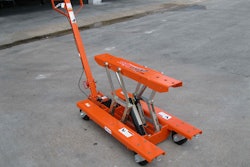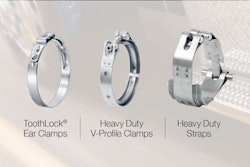Bendix Commercial Vehicle Systems manufacturing facilities are humming this year, as the company reports Monday that it has achieved production milestones across four product lines to meet increasing market demand.
Bendix says it is setting new company benchmarks for numbers of remanufactured brake shoes, air disc brakes, actuators, and vibration engine dampers produced. The company makes brake shoes at its Huntington, Ind., campus; air disc brakes in Bowling Green, Ky.; actuators in Acuña, Mexico; and dampers in North Aurora, Ill.
“Reaching production milestones can happen only when employees work as highly unified teams. At Bendix, team members from every facet of the operation join in the name of accomplishing our safety and quality standards, while meeting our production goals,” says Carlos Hungria, Bendix chief operating officer.
“In this environment of increasing truck build and market growth, it’s as important as ever for everyone across the organization – including purchasing, quality, materials, maintenance, packaging and shipping, finance, engineering, and many more – to work with shared purpose and commitment. It is our ‘One Plant’ approach that makes the difference.”
New Brake Shoe Standard
Bendix began serial production of remanufactured brake shoes at its 74,000-sq.-ft. Huntington facility in the fall of 2012. Since then, the rate of production at the brake shoe operation has steadily increased to meet growing demand from fleets and owner-operators wishing to maintain the quality, performance, and compliance of their Reduced Stopping Distance (RSD) brakes when replacing shoes, while optimizing value.
Today, the center is producing upwards of 7,000 brakes shoes per day, up from a previous high of 6,321 in July of 2016. Bendix says it is on target to produce 1.64 million shoes in 2017, an increase of nearly 30 percent over the former record of 1.28 million shoes manufactured in 2016. The company has produced nearly 5.8 million shoes since the operation’s start in 2012.
The Huntington facility handles the complete salvage, coining, and assembly processes that make up start-to-finish brake shoe remanufacturing, Bendix says.
“Demand continues to grow for reman brake shoes that maximize safety and performance, and provide full service life by resisting premature lining wear and rustjacking,” says Mike Pogorelc, Huntington plant manager. “Our focus is squarely on increasing production growth to meet this market need.”
The Air Disc Brake Trajectory
Bendix Spicer Foundation Brake LLC (BSFB), a joint venture between Bendix Commercial Vehicle Systems LLC and Dana Commercial Vehicle Products, LLC, introduced the Bendix ADB22X air disc brake in 2005 – a first for the North American marketplace. Since 2009, annual production levels have risen significantly.
BSFB is forecast to produce an average of more than 1,800 air disc brakes (ADB) per day for 2017. In 2016, the company averaged 1,181 per day, with a peak of 1,320. Thanks to the growing market demand, year-over-year growth is nearly 50 percent, and quarter-over-quarter, 22 percent, the company says.
“Our production growth is noteworthy because it signals an increasing adoption of air disc brakes in the North American market – and of the Bendix air disc brake specifically,” says Fred Stevens, plant manager at the Bowling Green facility, which produces the brake. “We’ve seen a number of large line haul fleets converting to all-wheel ADB on their tractors and trailers, as well as OEMs improving how the air disc brake is positioned in their data books. As the production requirements go up, the Bowling Green team will continue rising to the occasion.”
Stevens cites ADB growth in the trailer market as another key contributor to customer demand. Overall, because of increasing market adoption by fleets and owner-operators, the brake now accounts for more than 1.7 million wheel-ends on the road, Bendix says. Today, more than 20 percent of North American Class 6-8 air-braked wheel-ends are equipped with ADBs. That is a 50 percent increase in overall market share since 2013.
BSFB says it expects the upward trajectory to continue.
Actuator Benchmark
Growing demand for air disc brakes is spurring production growth of actuators as well. This growth is contributing to what is expected to be the highest volume year for actuators since they began production in Bendix’s Acuña, Mexico, manufacturing facility in December 2010. The operation is on pace to produce an average of 8,300 actuators per day, a 10 percent increase over the 2016 number of 7,600, the company says.
“With Bendix being the leading producer of air disc brakes for commercial vehicles in North America, the increasing market adoption of ADB translates into production growth for Bendix air disc brake actuators,” says Jackie Perez, plant manager of the Acuña operation. “The concerted effort of every team member is the reason our production facility can answer the market’s call for more and more actuators.”
In addition, Perez noted, increasing numbers of aftermarket customers are also turning to the Bendix EverSure Spring Brake, as they seek better performing foundation drum brake products at competitive prices.
“So often, an aftermarket user of a spring brake will look for the lowest cost option, but the lowest cost option in a spring brake almost always equals the lowest performance and life.”
Bendix expects its actuator production growth to endure, as the take-rate of air disc brakes and the number of customers turning to Bendix EverSure continue to increase, and the company acts on other major opportunities across all actuator product lines, the company says.
High Bar for Dampers
Finally, vibration engine dampers are used to reduce torsional vibration on engine crankshafts to prevent shaft failure and reduce noise. Month by month, Bendix says it is reaching new milestones in damper production, as the last three months demonstrate.
In June, the company produced 23,163, a 58 percent increase over the June 2016 number of 14,635. The increased production mirrors the 88 percent year-over-year and 41 percent year-over-year experienced in May and April, respectively.
The growth reflects the overall expansion of truck build, along with increased demands by key OEM customers, according to Steffen Daberkow, plant manager of the North Aurora facility, where Bendix produces dampers. Another driver of growth is the role dampers play in improved fuel efficiency.
“We went through engineering changes and updates of the dampers for newer generations of engines,” Daberkow says. “As the dampers are specifically designed for each engine, we are part of the development at the engine builders for better fuel economy. The team here continually looks for ways to elevate our OEM partnerships, from the development side to increasing production growth.”











